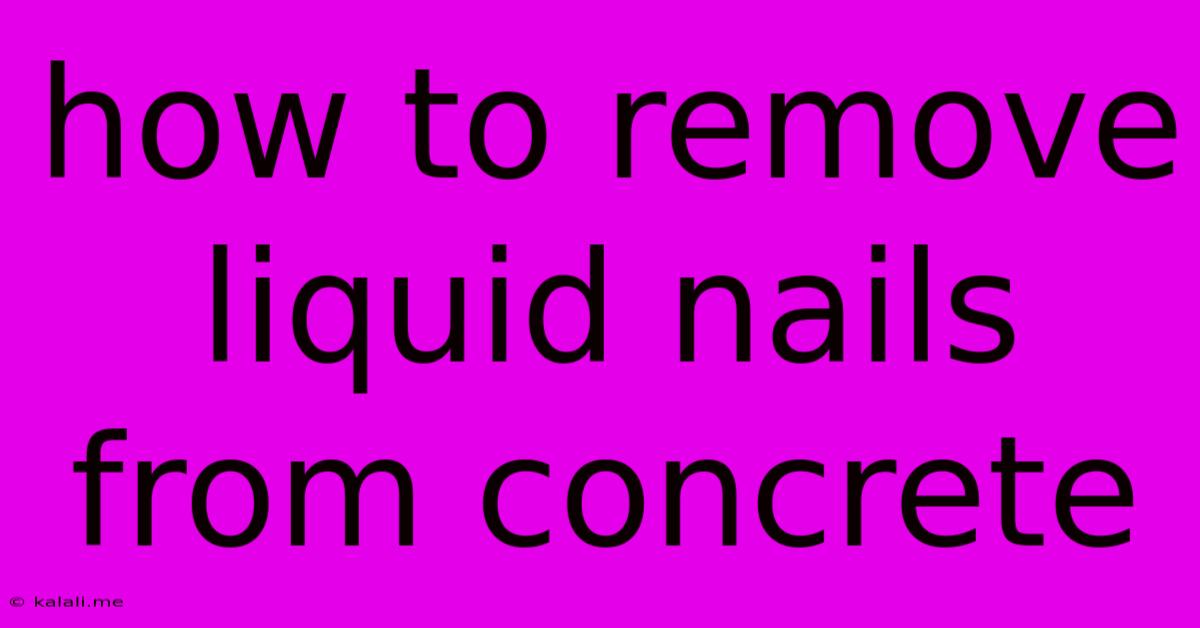How To Remove Liquid Nails From Concrete
Kalali
Jun 01, 2025 · 3 min read

Table of Contents
How to Remove Liquid Nails from Concrete: A Comprehensive Guide
Removing liquid nails from concrete can be a frustrating task, but with the right approach and tools, it's entirely manageable. This comprehensive guide outlines several effective methods, from simple scraping to the use of chemical solvents, helping you tackle this sticky situation efficiently and safely. This guide covers everything from preparation to cleanup, ensuring you achieve a clean and smooth concrete surface.
Understanding the Challenge: Why Liquid Nails is So Tough
Liquid Nails, a powerful construction adhesive, is designed to bond surfaces strongly. Its robust nature makes it incredibly effective for its intended purpose, but also means it's difficult to remove, especially from porous materials like concrete. The adhesive's strong grip and potential for deep penetration into the concrete's pores require a multifaceted approach to removal.
Method 1: The Physical Removal Approach
This method is best suited for smaller spills or recently applied liquid nails that haven't had time to fully cure.
-
Preparation is Key: Wear appropriate safety gear including gloves and eye protection. Use a putty knife or scraper to carefully loosen any softened adhesive. Work slowly to avoid damaging the concrete surface.
-
Tools of the Trade: A variety of tools may be necessary, from a stiff-bristled brush to a wire brush, depending on the amount of adhesive and its level of curing. A chisel might be useful for stubborn sections, but use extreme caution to prevent chipping the concrete.
-
Gentle Persuasion: Start with gentle scraping, gradually increasing pressure as needed. If the adhesive is still pliable, it should come away relatively easily. Remember consistent, controlled pressure is more effective than brute force.
-
Patience is a Virtue: Expect this process to be time-consuming, especially for larger areas. Take frequent breaks to avoid fatigue and ensure careful, precise work.
Method 2: Chemical Solvents – The Power of Chemistry
For more stubborn, cured liquid nails, chemical solvents offer a more effective solution.
-
Choosing the Right Solvent: Mineral spirits or acetone are common choices, but always test a small, inconspicuous area first to ensure it doesn't damage the concrete. Always follow the manufacturer's safety instructions for any solvent used.
-
Application and Removal: Apply the solvent liberally to the affected area, allowing it to penetrate the liquid nails for several minutes. Use a stiff brush or scraper to loosen the softened adhesive. Repeat the process as necessary. Remember adequate ventilation is crucial when working with solvents.
-
Post-Solvent Cleanup: Thoroughly rinse the area with water after removing the adhesive to neutralize any remaining solvent. Allow the concrete to dry completely before further treatment.
Method 3: Heat – A Different Approach
Heat can soften cured liquid nails, making removal easier. However, exercise extreme caution to avoid damaging the concrete or causing injury.
-
Controlled Heat Application: A heat gun can be used, but maintain a safe distance and move the gun constantly to avoid overheating the concrete. Focus the heat directly on the adhesive, not the concrete itself.
-
Heat and Scrape: As the adhesive softens, immediately scrape it away with a putty knife or scraper. Be prepared for this to be a gradual process. Never leave the heat gun unattended.
-
Safety First: Heat guns can reach extremely high temperatures. Always wear appropriate safety gear and exercise extreme caution. This method is best suited for experienced users.
Post-Removal Cleanup and Prevention
Once the liquid nails are removed, clean the area thoroughly with water and a stiff brush. Allow the concrete to dry completely. For future projects, consider using painter's tape to mask off areas you don't want adhesive to adhere to. This can help prevent future spills and the need for removal.
By following these methods and prioritizing safety, you can effectively remove liquid nails from concrete and restore your surface to its original condition. Remember that patience and a methodical approach are crucial for success.
Latest Posts
Latest Posts
-
Honeywell Water Heate Pilot Light Wont Stay Lit Fix
Jun 02, 2025
-
Configure No Such File Or Directory
Jun 02, 2025
-
How To Clean Tile Floors And Grout
Jun 02, 2025
-
How Do Some Professors Give Lectures Without Any Notes
Jun 02, 2025
-
Should You Toast The Bread Of A Cold Sandwich
Jun 02, 2025
Related Post
Thank you for visiting our website which covers about How To Remove Liquid Nails From Concrete . We hope the information provided has been useful to you. Feel free to contact us if you have any questions or need further assistance. See you next time and don't miss to bookmark.